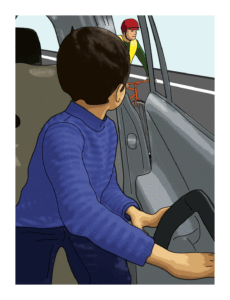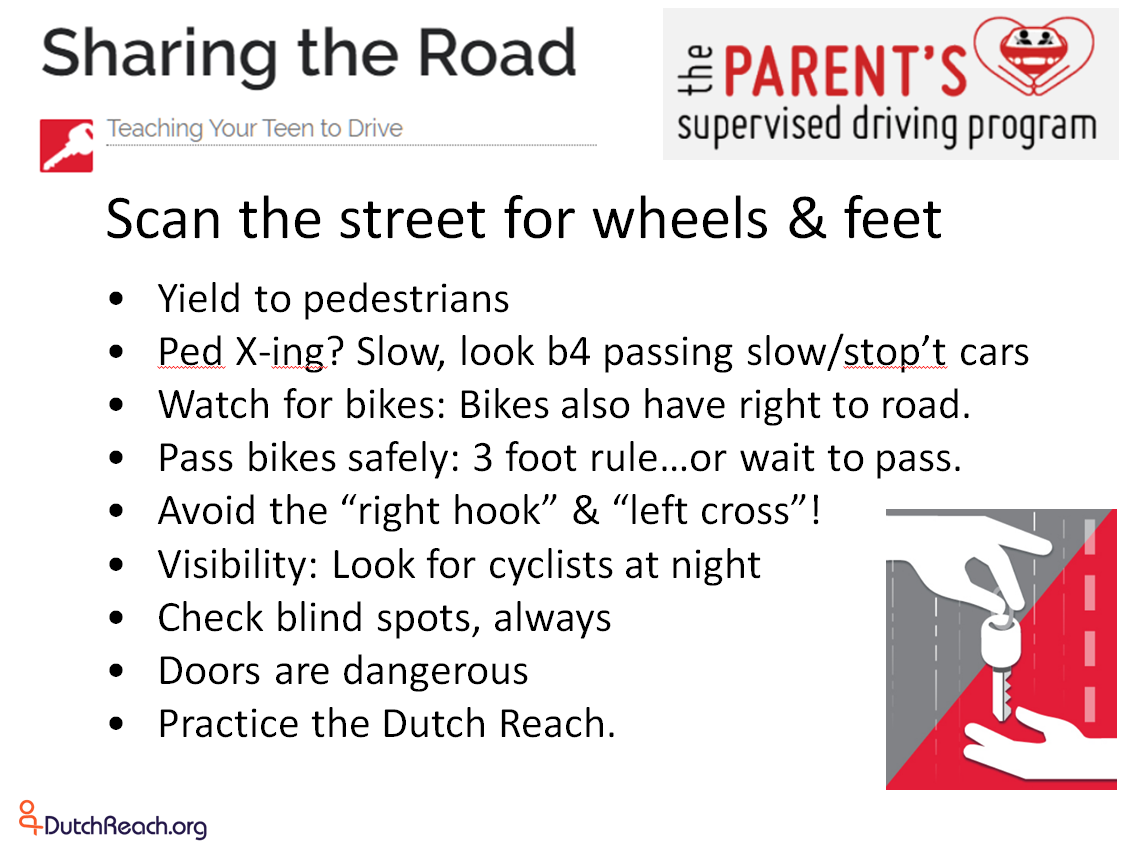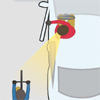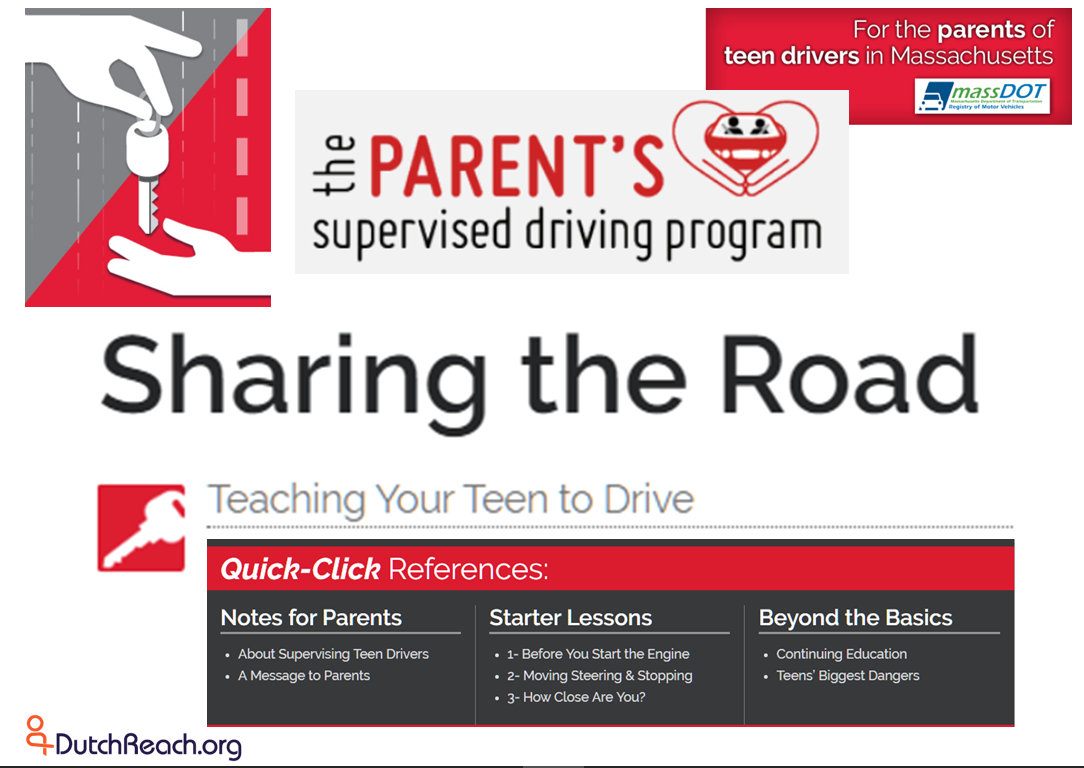
Teach your kids the Dutch Reach & they'll teach you back!
Spread the word!
Teach the 'Reach' to School Kids, Teens & Parents too!
Contact your local school committee, PTO or PTA, etc. and ask that the method be taught to children and teens in health & safety curricula, bike & driver's education curricula. Educate parents who drive kids to school to assure their kids use the far hand method to avoid dooring students or other cyclists when their kids 'kiss & run'.
The Parents Supervised Teen Driver Program (Massachusetts edition) has a section on Road Sharing which teaches the Dutch Reach - which may be copied and shared.
Age appropriate teaching materials or modules for elementary school need to be developed! If you are artistic, creating simple 'childrens' book' style graphics & text would be very useful to make and share back to our Project!
! Note: ALL menu boxes have content. Double click to open
PSDP Share the Road Topics

Click on image to enlarge. Click here to view &/download complete MA PSDP guide. See pages 40 & 41 for for the "Share the Road" section which now includes the Dutch Reach.
Road Sharing for Teens
A Call to Far Arms
If you believe that the Reach habit is what the Dutch claim it to be, obviously wiser than our own near-hand habit, I hope we can help each other get this message out and make bicycling in our communities significantly safer.
Word of mouth and web has gotten us a fast start with some great press and a viral video to introduce the Dutch Reach. Yet it took 50 years since its "invention" to cross the Atlantic with any notice.
'Show & tell' we all can do, and it may take us a fair distance forward. So please do share this method and the website! Share it on Facebook, Twitter (see, RT #dutchreach, #dooring), on blogs, comments & other social media. Be sure your local cycling and safe roads groups are on to it, and promoting it to local transportation authorities and driver education instructors.
But to make the Reach popular and permanent some of us will need and want to do more.
So here are some asks & ideas for you and group action.
1. We need 'open source' tools to put the Reach into common practice.
We need to stock the 'Dutch Reach' Advocacy Toolkit to equip cycling and safe street advocates. Sharing makes it easy for groups to start and be effective.
For our outreach campaigns, we need "marketing" materials & skills: graphics, flyers, stickers, brochures (A) (B) (C), messaging and talking points, social media content, videos, writers, 'spokes'-people, IT & organizing talent, etc.
We also need special things such as driver education teaching materials and curricula modules, stuff suited for school kids, parents, ride-share drivers and passengers, bicycle shops, gas stations and car dealerships, insurance companies, medical and emergency personnel etc..
We need model resolutions and proposed legislation: 'asks' & proposals for officials and public servants. We need to propose our good ideas in ways to make their jobs easier, for example:
- Proposals for re-training all public and private fleet drivers to use the Reach method,
- Teaching the Reach starting in grade school.
- Model bills or amendment language to require the state RMV/DMV/DOT/DfT to add and update bicycle and pedestrian issues for drivers, not just the Reach in State or National driver education manuals and vehicle operator licensing examinations need to reflect the increasingly multi-modal state of our roadways -- the new signage, painted sharrows, bike lanes, bike boxes, door zones, bike traffic signals , 3 & 4 foot passing rules, avoiding right and left hooks, yielding rules, and advice about road sharing, etc.
- Make public contracts require that all vendors and contractors assure that their drivers learn and use best practices for shared-use roads,
- To require the posting of instructional signs about driver road rules and information on new signage & infrastructure protecting bicycles and pedestrians, at all construction sites, garages, truck and fleet lots, etc.
- Encourage insurers to recognize new driver safety standards and to promote the Dutch Reach to their insured, even if a given state's drivers manuals and licensing requirements as yet do not.
Any individuals or groups who are willing to take on these tasks and craft such campaign materials, please do! And then please share your 'tools' with the rest of us! Please send me your campaign-ware and I'll post them in the Toolkit for down-load everywhere.
2. The Reach presents both broad-base fields and specific points of outreach, education, decision-making and action. Some are vast if shallow, with viral potential. Others are occupied by besieged bureaucrats and public officials. Experienced activists and advocates know how in general to proceed. But every change campaign has unique features and opportunities to influence key groups and decision makers.
3. If new to activism, you well may ask, 'How should I start?' My advice is to read up on doorings, door zones, infrastructure solutions and the Reach method itself, starting with this website and some of the media reports on it -- which probably brought you here. Then connect to your local bike/street safety organization and try to get them interested and work with them. Or find other like-minded cyclists (usually) who want to work on this, and together you can figure out how to start moving, gather others to the cause, and fashion a fledgling campaign.
The Advocacy Toolkit on this site is here to help with ideas for action and useful resources. It will be getting better and bigger as our efforts mature and are shared here, so keep checking back.
4. Who is this for? We cyclists should be the earliest adopters and biggest boosters and proselytizers of the Reach, whether casually or deliberately talking it up amongst ourselves and outward through family, friends, co-workers who know we bike.
Doorings strike close for cyclists in older cities with narrow streets, parallel parking and a rising tide of urban cyclists. Roomy younger cities and suburbs with wide streets, off street and angled parking, malls and parking lots, not so much. (If anyone out there is willing to work the ex-urban geography, great! Many folks from the countryside come to visit, drive, live and bike in the city, and are unprepared for cyclists and dooring risk.
But door crashes are not just a danger for cyclists -- though obviously we've got the most skin in this game. Everyone is a driver, a passenger, a parent, sibling, co-worker, family or friend. We need to protect ourselves and each other. And getting out of cars near traffic can be dangerous for anybody.
5. Reaching beyond our own social groups, we will discover others who may be well positioned to help -- or hurt. We may need different messaging and media to interest them.
Looking at demographics, the rising tide of Millennials who forgo car ownership or even drivers licenses, is major. As some take to bikes, skateboards and scooters, and Copenhagen wheels etc., others now jump in and out of Ubers & Lyfts. And by friction-less electronic pre-payment we're seeing a rise in careless mid-street and drop-off doorings from left and right into the 'bike lane' or corridors. It's gotten so common around the globe its got a name of its own: "The Uber/Lyft Effect."
But Millennials, and for sure Uber/Lyft drivers are smart phoned in to social media, and getting viral with some hot social messaging could transform awareness -- if not yet behavior -- at thumb-click speed. So thank you Outside Magazine Online for your free, funny, entirely unsolicited Dutch Reach video!
We may need more of the same and even wicked better if possible, but certainly we now have real gift with that video. Let's share it!
6. Other demographic groups with their own dooring-related issues are age-ing Boomers, some who are returning from the 'burbs to the city and taking up walking, bicycling and recreational cycling. They also have children and grandchildren whose safety and well-being is a great concern. Bicycling commuters and car-free multi-modal adults are also natural allies. Other road users are also at risk: Think motorcyclists, moped users, roller bladers, skate & hover boarders, even joggers.
7. A second, less obvious but deeply important audience of truly early adopters should be school kids! For one thing, here "kiss and run" drop offs in mid-street can be kiss and be killed, as I saw nearly happen on a routine 8:30 am commute outside a public school. The cars were of course stuck in traffic. A back door opened (from the left) into the bike lane at the bottom of a hill. Fortunately the child was using her far hand and peeked out first, looking directly back before opening more fully and stepping out.
As in the Netherlands, parents and teachers can and should teach and model the Reach from car-seat & "passenger-hood" on up. A little creativity in drawing class, PTO/PTA memos to parents, posters, bike lessons in gym, talks by friendly Police Officers etc., could go a long way. Middle school health & safety classes are also appropriate venues to teach the Reach. For high school teens, driver ed class is a must do, so creating room in the curriculum and hand-outs, as well as prime time watching YouTube send-ups of the Reach, would work here.
8. Reaching car-bound commuters, shoppers and tourists are another distinct challenge, as they are most likely but for the commuters, to be unfamiliar with our flocks of cyclists invading their assumed turf. Here we should get our local traffic and police to deploy Mobile Electronic Traffic Signs to teach country-folk the Reach, and other rules of the road and advisories where urban bicycle traffic is the new normal. Of course we first have to re-train ourselves and our own towns people.
9. Signage! Yes~!
Here's a true challenge for some outre graphic artists... with fame, glory & bragging rights for the victor!
We need sticker graphics and a universal logo -- one which 'says it all' in a blink! Just try putting the Reach on an orange and black diamond, bike or bumper sticker, decal, or rectangular traffic sign! It's a difficult message to image, especially when no one knows what you're signing about. (For distraction, see the folder of Stickers in the Advocates Toolkit, collected from pre-Reach anti-dooring campaigns around the globe.)
Far easier but also much needed are stencil designs, graphics, or messaging for shirts, pavement, walls, coffee cups, key fobs, bumper stickers, etc.
We need such signs and messages stationed at major thoroughfares as well as at entry points into town, in rental cars as window and mirror decals, street signage, on parking meters, gas pumps, on backs, bike fenders and sides of buses, etc.
"Look Out for Bikes" and "Open With Care" and "Door Prize" stickers and signs of traditional anti-dooring awareness campaigns do raise vigilance, we all hope, but don't seal the deal.
The advantage of the Reach though is that this generalized vigilance gets cooked into muscle memory, a habit and motion when and where it counts. Sort of "Point of Sale" safety. And the habit of looking out back every time you exit a car also ups vigilance and respect for bikes while driving also. You're n regularly practicing 'Look out for bikes.'
10. Fleets. We already considered Uber & Lyft. But rather than waiting for the to finally get religion, we should push them, yes? -- So shame them if you must, praise them if you can, but start a ground swell to push them to get their drivers and passengers to obey the law.
But there are also hosts of public, private and commercial fleets out there. Taxis, jitneys, police, fire and public works, ambulances, tradesman vans, landscaping and delivery trucks of every dimension, dump trucks, straight trucks, rental trucks, school buses, city buses, passenger coaches, cabs and rigs, flatbed and cargo. All with their notorious blind spots and blind wedges, bulk and height, impeded or absent side and rear views. They put our bicyclists as well as other active transport citizenry at greatest danger. We need to find ways to enlist their fleet managers and improve drivers' bike/pedestrian precaution all around.
On this the City of San Francisco has an excellent training video which they are showing to scores of fleets in the Bay Area. It comes with the spell-binding title "Large Vehicle Urban Driver Safety Training" video. All 17 minutes of cyclist & pedestrian life-saving advice are to be found on YouTube, and even if you don't drive an18 wheeler for daily errands it is really truly worth seeing things from the other side. Though as yet unnamed as such in 2015, the Reach is demo'd at minute 14.30.
11. Nothing in this screed and plea should be construed to deny or ignore the overwhelming important of wise and widely implemented infrastructure. That's what the Dutch have now too, which makes the Reach not so critical as it is here, and getting worse. While we wait for build out of separate tracks etc., today and tomorrow we want to get to get home safely. The Reach is no substitute for engineered fail-safe planning, traffic management, and for getting built-out infrastructure built. And its no excuse not to push hard for that solid solution at the same time. Nor is this a matter of who's most at fault or who alone should change.
Don't let anyone get us into a argument about infrastructure versus individual responsibility, or cyclist's vs driver's. Rather let's note the 3 to 5 safety E's of Vision Zero (the international movement for zero street fatalities). They are: Engineering, Education, Enforcement, Encouragement and Evaluation, to which we may add Equipment (as in mirrors, reflector vests and light, even bike sensing radar and door-edge lights, etc.).
The 'Reach' is not a substitute for engineered solutions: where you can put them, when you can win the political fight, and fund the costs to build them out. But the 'Reach' is a re-engineered habit which by training and use becomes muscular and automatic.
The Reach is not a substitute for all other cyclist, driver and passenger Education and vigilance efforts. But it does provide a unique safety advantage for this preventable danger. It travels well and far, works for free everywhere cars stop or park parallel to cyclists.
The Reach per se may prove impossible to Enforce, but anti-dooring fines, liability and punishment clearly has a role albeit enormously neglected. But the fear of legal consequences -- liability, license loss, criminal charges and civil damages as a motivator, for insurance companies if not most drivers, should not be ignored. And auto insurance companies -- as well as the medical establishment and its institutions and providers -- could and should become our allies in outreach and education as the Reach is for sure a matter of specific driver, passenger and corporate behavior and responsibility. Also people usually sleep better if they haven't killed or crippled someone else, especially when a safer, commonsense, thoughtless habit is more likely to prevent it.
Teaching old dogs to hunt may be a difficult task, but Encouragement is part and parcel of this Dutch Reach pitch. No question there. And once the habit takes hold, you're good to go.
Evaluation actually works here too. It is of course a staple of education, both by parents and teachers, but also by peer pressure. And school kids are notorious once taught to hold their parents and friends to the rules, be it buckling up, recycling or no smoking.
In closing, you should know that good as now is for pedestrians, cyclists and motor vehicles in Holland, the path to peaceful co-existence on their roads was not won without tragic deaths, anger protest and hard political work.
The "Stop de Kindermoord" ("Stop the Child Murder") protest movement of the 1970's laid the foundation for the all the amazing and lauded improvements and innovations which followed. Read about that dark period in Holland and reflect. Can we not learn from their tribulation and hard fought example? Can we not achieve such safeness without such suffering?
Note: No passing the plate or hat here. Better to fund your local bicycle organization to teach and advocate the Reach. Or start and fund your own individual or group effort. I wish you the best.
Revised: 19 Feb 2017

